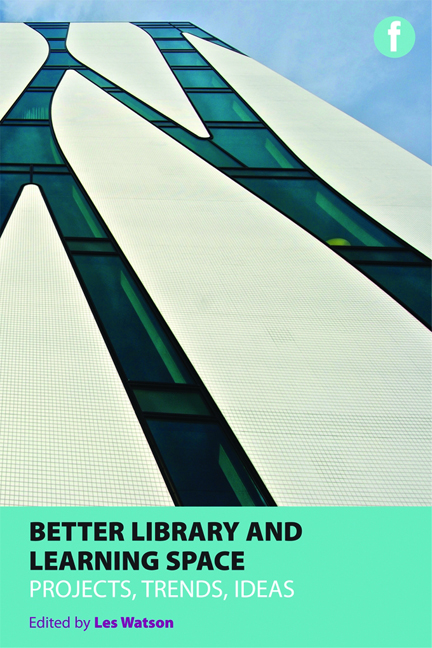Book contents
- Frontmatter
- Contents
- Case studies
- Acknowledgements
- Contributors
- Introduction – about this book
- PART 1 PROJECTS AND TRENDS
- PART 2 TRENDS AND IDEAS
- PART 3 IDEAS AND FUTURES
- Introduction
- 11 Beyond space: access is all – or is it?
- 12 Thinking inside the box
- 13 Nothing has changed/everything has changed – the enduring aspects of learning
- 14 Books, nooks and MOOCs
- 15 The researcher's view: context is critical
- 16 Libraries in the network society: evolution, revolution, extinction?
- 17 Powered by learning: developing models of provision to meet the expectations of new generations of students
- 18 The library has left the building
- 19 Beyond analogue: the learning studio as media-age library
- 20 3D libraries for 3D smarting
- 21 Learning landscapes, the library and the University of Lincoln: efficiency, effectiveness, expression and experimentation
- 22 Viral design: learners building better environments together
- 23 The interior designer's view
- 24 Furniture fit for the future – a brief exploration of library and learning furniture today and for the coming generation
- 25 Conclusions
- Index
22 - Viral design: learners building better environments together
from PART 3 - IDEAS AND FUTURES
Published online by Cambridge University Press: 08 June 2018
- Frontmatter
- Contents
- Case studies
- Acknowledgements
- Contributors
- Introduction – about this book
- PART 1 PROJECTS AND TRENDS
- PART 2 TRENDS AND IDEAS
- PART 3 IDEAS AND FUTURES
- Introduction
- 11 Beyond space: access is all – or is it?
- 12 Thinking inside the box
- 13 Nothing has changed/everything has changed – the enduring aspects of learning
- 14 Books, nooks and MOOCs
- 15 The researcher's view: context is critical
- 16 Libraries in the network society: evolution, revolution, extinction?
- 17 Powered by learning: developing models of provision to meet the expectations of new generations of students
- 18 The library has left the building
- 19 Beyond analogue: the learning studio as media-age library
- 20 3D libraries for 3D smarting
- 21 Learning landscapes, the library and the University of Lincoln: efficiency, effectiveness, expression and experimentation
- 22 Viral design: learners building better environments together
- 23 The interior designer's view
- 24 Furniture fit for the future – a brief exploration of library and learning furniture today and for the coming generation
- 25 Conclusions
- Index
Summary
The way it was
As we look back, the 1950–2000 era of education already seems like an aberration. A rapid population growth post Second World War in Britain and elsewhere led to a panic move into industrial scale learning. At one point in the 1970s England alone was opening a school every weekday to keep pace with the post-war baby boom and a design plague of galvanized windows and revolting toilets were just some of the sad consequences. The design of learning space was something that was done for children or, perhaps more accurately, something that was done to them. Children were subjects (Rosenthal and Jacobson, 1968), but rarely collaborators. The libraries in these factory schools, with racking, stacking and rules, were often uninspiring too. Children would have done it differently. When eventually we asked them, they did.
Co-construction
Happily, as the panic baby-boom building, and the shock of the inequalities revealed by conscription, all calmed a little, the rhetoric of education began to see the learners themselves as helpful co-constructors. With time to do it better, for some it made sense to do it together. In the 1980s and 1990s this rhetoric of co-construction grew, propelled in part by the impact of educational technology. From the 1980s, with BBC and Research Machines computers in UK schools, it was clear that children, with their Spectrums and Commodores at home, had a capability that we would ignore at our peril. Smart schools embraced the geeks within the student body and a feverish two decades of programming, robotics, art installations and more saw children very much as co-creators of a digital curriculum in classrooms and clubs. Libraries then were at serious risk of being left behind – an analogue backwater in a digital world.
However, for perhaps the first time since the 1944 Education Act, many were comfortable to acknowledge that children might, in some ‘modern tech’ areas, know as much or more than their teachers. The confident, creative, empowered children who emerged from this collaborative era today form the backbone of the colossal and lucrative UK creative industry of games, SFX, animation, advertising, fashion and more. That creative industry is second only to banks’ scale in our economy (NESTA, 2011).
- Type
- Chapter
- Information
- Better Library and Learning SpaceProjects, trends and ideas, pp. 241 - 248Publisher: FacetPrint publication year: 2013



